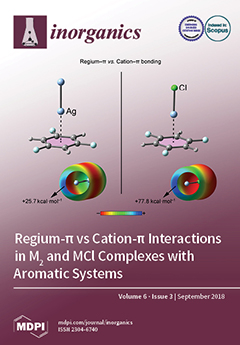Novel pillared-layered framework materials were synthesized by high-throughput or microwave-assisted methodology that contain Mg
2+ and the zwitterionic linker HDTMP (hexamethylenediamine-
N,N,N′,
N′-
tetrakis(methylenephosphonic acid)). Three compounds were structurally characterized by X-ray powder diffraction. In the compound {Mg[(HO
3PCH
[...] Read more.
Novel pillared-layered framework materials were synthesized by high-throughput or microwave-assisted methodology that contain Mg
2+ and the zwitterionic linker HDTMP (hexamethylenediamine-
N,N,N′,
N′-
tetrakis(methylenephosphonic acid)). Three compounds were structurally characterized by X-ray powder diffraction. In the compound {Mg[(HO
3PCH
2)
2N(CH
2)
6N(CH
2PO
3H
2)
2]·(H
2O)}
n(
1), obtained at 140 °C by hydrothermal or microwave-assisted reaction, the layers are built by isolated Mg
2+ octahedra coordinated by oxygen atoms from six different zwitterionic HDTMP ligands. Each amino-
bis(methylenephosphonate) moiety links three Mg
2+ ions, bridging two of them through one phosphonate group and connecting the third polyhedron in a monodentate fashion. In Compound
2, {Mg[(HO
3PCH
2)
2N(CH
2)
6N(CH
2PO
3H
2)
2]}
n, hydrothermally synthesized at 180 °C, the layers are composed of bidentate amino-
bis(methylenephosphonate) moieties connected to three Mg
2+ ions, with one of the phosphonate groups acting as a bridging ligand. Various subtle structural changes are noted for the other two compounds. Thermodiffraction of
1 reveals that a crystalline-to-crystalline phase transformation occurs concomitantly with its dehydration, leading to a new anhydrous phase, namely, {Mg[(HO
3PCH
2)
2N(CH
2)
6N(CH
2PO
3H
2)
2]}
n(1deh). This process is fully reversible upon equilibrating the solid at room temperature. The reported compounds can adsorb ammonia and CO
2. Compound
1 exhibits a moderate proton conductivity, ~1.5 × 10
−5 S·cm
−1 at 80 °C and 95% RH, that increases a half order of magnitude after experiencing a complete dehydration/rehydration process,
1→
1deh→
1.
Full article





